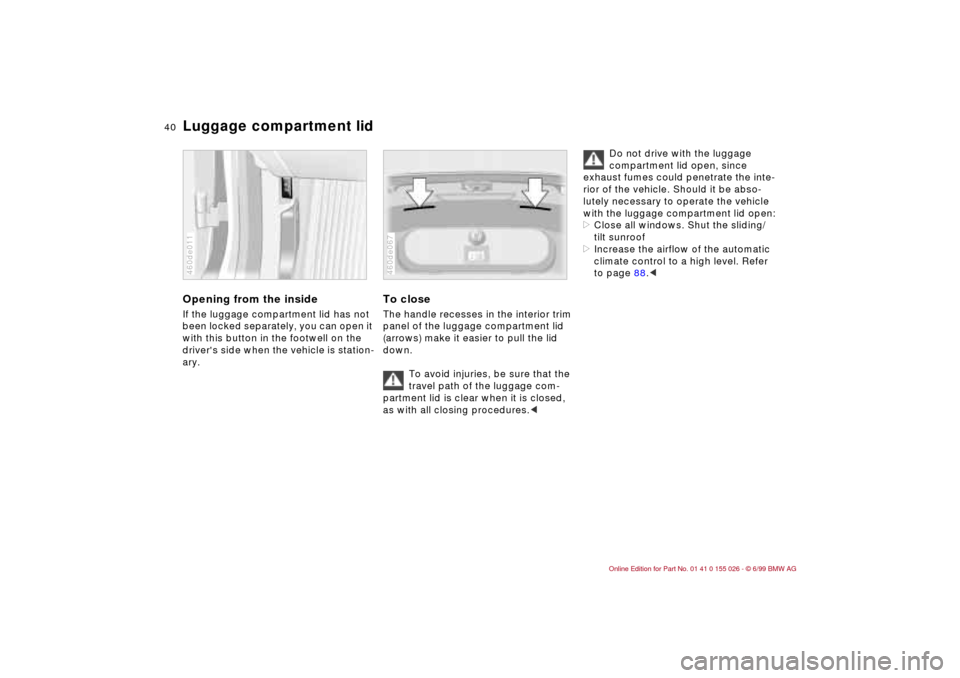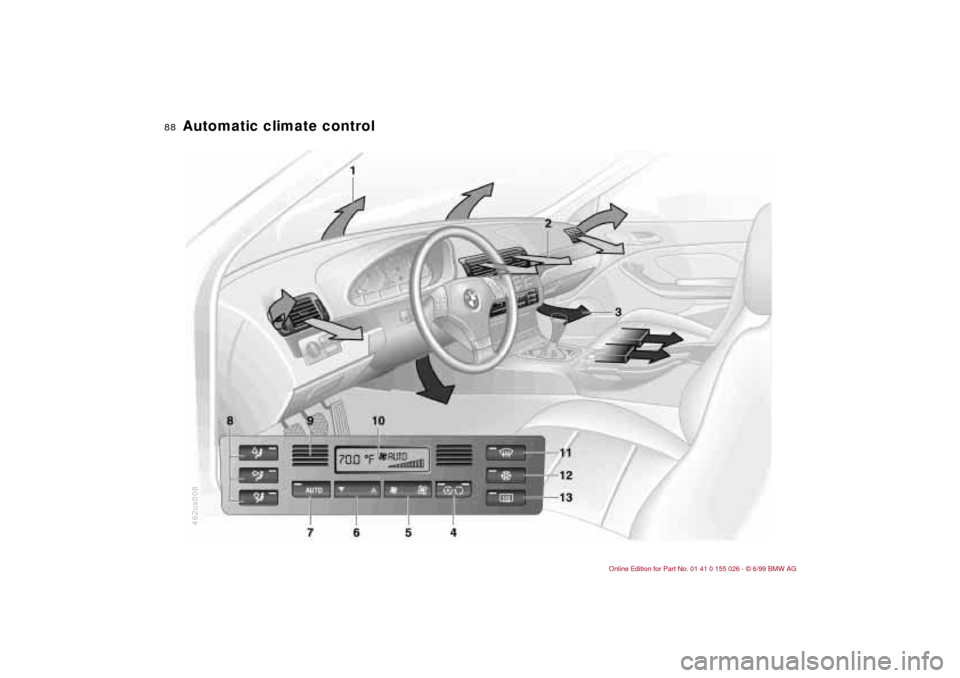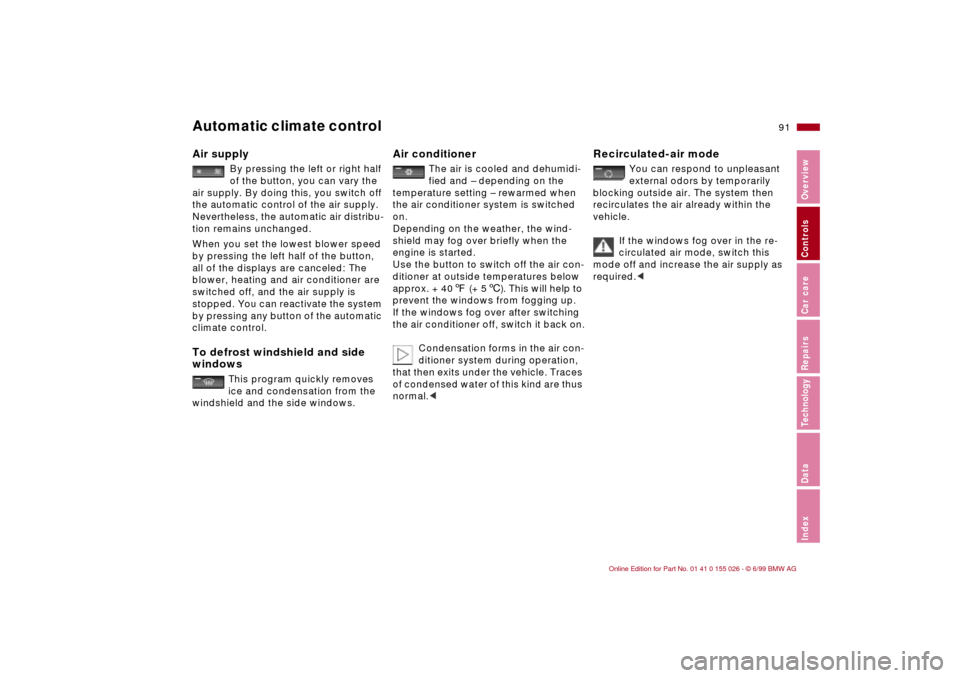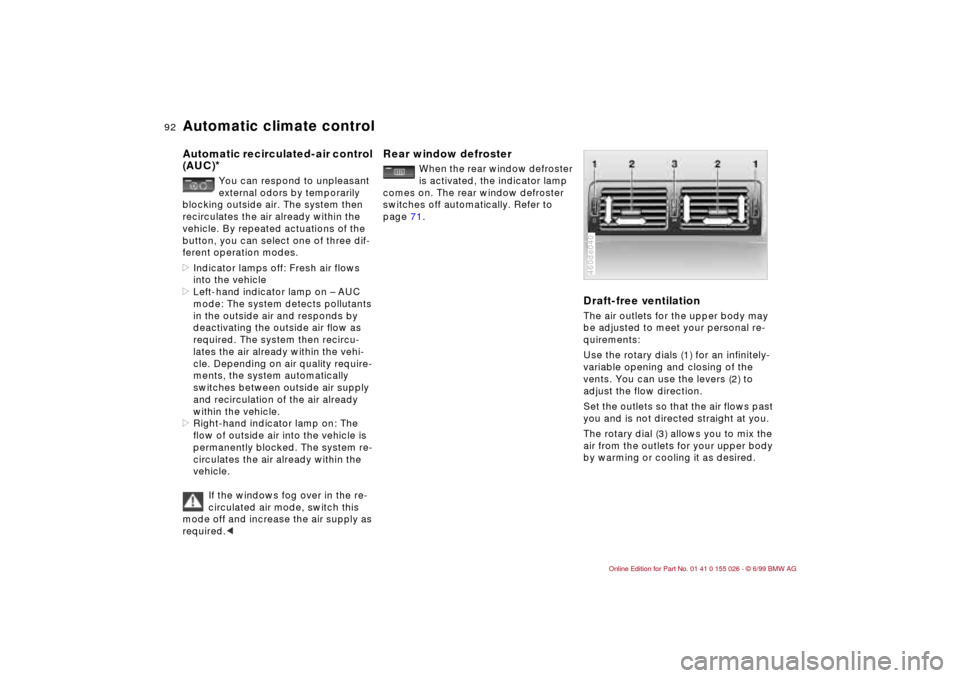2000 BMW 328Ci COUPE climate control
[x] Cancel search: climate controlPage 13 of 189

11n
Controls and features
Operation, care and maintenance
Lamps:
Parking lamps/Headlamps84
Instrument panel rheostat84
High beams/Parking lamps85
Fog lamps85
Interior lamps85
Reading lamps86
Controlling the climate
for pleasant driving:
Automatic climate control88
Heated seats93
Roller sun blind93
Cabin convenience:
HiFi System94
Glove compartment94
Storage compartments95
Cellular phones95
Ashtray96
Cigarette lighter96
Clothes hooks97
Loading and transporting:
Through-loading facility98
Ski bag99
Cargo loading100
Roof-mounted luggage rack101
Special operating instructions:
Break-in procedures104
Driving notes104
Catalytic converter105
Antilock Brake System
(ABS)106
Disc brakes108
Brake system109
Winter operation110
Power steering112
Cellular phones112
Radio reception112
Wheels and tires:
Tire inflation pressures113
Tire condition113
Tire replacement114
Tire rotation114
Wheel and tire
combinations115
Winter tires116
Snow chains116
Approved wheel and tire
specifications117
Under the hood:
Hood119
Engine compartment120
Washer fluids122
Washer nozzles122
Engine oil123
Coolant126
Brake fluid127
Vehicle Identification
Number128
Care and maintenance:
The BMW Maintenance
System129
Caring for your car130
Airbags135
Vehicle storage136
Laws and regulations:
Technical modifications
to the vehicle136
OBD connector137
Page 33 of 189

Overview
Controls and features
Operation, care
and maintenance
Owner service procedures
Technical data
Index Advanced technology
31n
RepairsIndexOverview Controls Car care Technology Data
Manual transmission65
Automatic transmission with
Steptronic66
Turn signal/Headlamp flasher69
Wiper/washer system/Rain
sensor69
Rear window defroster71
Cruise control72
Everything under control:
Odometer74
Tachometer74
Energy control74
Fuel gauge75
Temperature gauge75
Service Interval Display76
Check Control77
Clock77
Onboard computer77
Technology for safety and
convenience:
Park Distance Control (PDC)80
Dynamic Stability Control
(DSC)81
Tire Pressure Control (RDC)82Lamps:
Parking lamps/Headlamps84
Instrument panel rheostat84
High beams/Parking lamps85
Fog lamps85
Interior lamps85
Reading lamps86
Controlling the climate
for pleasant driving:
Automatic climate control88
Heated seats93
Roller sun blind93
Cabin convenience:
HiFi System94
Glove compartment94
Storage compartments95
Cellular phones95
Ashtray96
Cigarette lighter96
Clothes hooks97
Loading and transporting:
Through-loading facility98
Ski bag99
Cargo loading100
Roof-mounted luggage rack101
Page 42 of 189

40n
Luggage compartment lidOpening from the inside If the luggage compartment lid has not
been locked separately, you can open it
with this button in the footwell on the
driver's side when the vehicle is station-
ary.460de011
To closeThe handle recesses in the interior trim
panel of the luggage compartment lid
(arrows) make it easier to pull the lid
down.
To avoid injuries, be sure that the
travel path of the luggage com-
partment lid is clear when it is closed,
as with all closing procedures.<460de067
Do not drive with the luggage
compartment lid open, since
exhaust fumes could penetrate the inte-
rior of the vehicle. Should it be abso-
lutely necessary to operate the vehicle
with the luggage compartment lid open:
>Close all windows. Shut the sliding/
tilt sunroof
>Increase the airflow of the automatic
climate control to a high level. Refer
to page 88.<
Page 90 of 189

88n
Automatic climate control
462us008
Page 91 of 189

89n
RepairsIndexOverview Controls Car care Technology Data
Automatic climate control1 Air on the windshield and on the
side windows
2 Air flow toward upper body
The side rotary dials provide infi-
nitely-variable regulation of the air
supply, while the levers change the
air-flow direction. The center rotary
dial adjusts the temperature of the
air as it flows out, see page 92
3 Front footwell ventilation
There are corresponding air vents
in the rear footwell as well
4 Recirculated air mode/Automatic
recirculated-air control (AUC)
*
91, 92
5 Air supply91
6 Temperature90
7 Automatic air distribution90
8 Individual air distribution90
9 Air grill for interior temperature
sensor – please keep clear and
unobstructed
10 Display for temperature and air
supply90
11 Defrost the windows and remove
condensation91
12 Air conditioner91
13 Rear window defroster71, 92
Page 92 of 189

90n
Automatic climate controlTips for pleasant drivingUse the automatic system; switch on
AUTO-button 7. Select an interior tem-
perature that is comfortable for you
– we recommend 707 (226) as a
comfortable setting. When the outside
temperature is above 407 (+ 56), you
can also use the air conditioning system
(12). This system dries the air and pre-
vents condensation on the windows
(e.g. if persons are wearing damp cloth-
ing). Set the outlets (2) so that the air
flows past you and is not directed
straight at you. Set the rotary dial be-
tween the air outlets (2) for the upper
body to a medium position, since air
that is somewhat cooler promotes driv-
ing without fatigue.
Detailed setting options are described
for you in the following section.
You can make the settings of your
vehicle in such a manner that,
when you unlock the car with your per-
sonalized remote control, your own per-
sonalized setting of the automatic cli-
mate control is initiated.<
Automatic air distribution
The AUTO program assumes
the adjustment of the air distri-
bution and the air supply for you and in
addition adapts the temperature to
external influences (summer, winter) to
meet preferences you can specify. This
program maintains a comfortable in-car
climate regardless of the season. Select
an interior temperature that is comfort-
able for you – we recommend 707
(226). The temperature selected and
the word AUTO for the air supply
appear in display (10) (refer to the over-
view on page 88). Open the air outlets
for the upper body area. Switch on the
air conditioner in warm weather. The
maximum cooling capacity is achieved
when you set rotary dial (3) (refer to
page 92) to cold.
Individual air distribution
You can cancel the AUTO pro-
gram by selecting specific distri-
bution patterns to suit your own
individual requirements. You
can direct air to flow onto the windows
, toward the upper body , and into
the footwell .
Temperature
The figures in the display provide
a general indication of interior
temperature. We recommend 707
(226) as a comfortable setting, whether
the air conditioner is operating or not.
When you start the vehicle, the system
ensures that the selected temperature is
reached as quickly as possible. It then
maintains this temperature, regardless
of the season.
Set rotary dial 3 (refer to "Draft-free
ventilation" on page 92) to a medium
setting, since air that is somewhat
cooler promotes driving without fatigue.
You can use this setting for mixing air to
make minor comfort modifications.
The full, uncontrolled heater out-
put is available starting at an inte-
rior temperature setting of 907 (326).
At a setting of 607 (166), the full cool-
ing output is available when the air con-
ditioner is activated.<
Page 93 of 189

91n
RepairsIndexOverview Controls Car care Technology Data
Automatic climate control Air supply
By pressing the left or right half
of the button, you can vary the
air supply. By doing this, you switch off
the automatic control of the air supply.
Nevertheless, the automatic air distribu-
tion remains unchanged.
When you set the lowest blower speed
by pressing the left half of the button,
all of the displays are canceled: The
blower, heating and air conditioner are
switched off, and the air supply is
stopped. You can reactivate the system
by pressing any button of the automatic
climate control.
To defrost windshield and side
windows
This program quickly removes
ice and condensation from the
windshield and the side windows.
Air conditioner
The air is cooled and dehumidi-
fied and – depending on the
temperature setting – rewarmed when
the air conditioner system is switched
on.
Depending on the weather, the wind-
shield may fog over briefly when the
engine is started.
Use the button to switch off the air con-
ditioner at outside temperatures below
approx. + 407 (+ 56). This will help to
prevent the windows from fogging up.
If the windows fog over after switching
the air conditioner off, switch it back on.
Condensation forms in the air con-
ditioner system during operation,
that then exits under the vehicle. Traces
of condensed water of this kind are thus
normal.<
Recirculated-air mode
You can respond to unpleasant
external odors by temporarily
blocking outside air. The system then
recirculates the air already within the
vehicle.
If the windows fog over in the re-
circulated air mode, switch this
mode off and increase the air supply as
required.<
Page 94 of 189

92n
Automatic climate controlAutomatic recirculated-air control
(AUC)
*You can respond to unpleasant
external odors by temporarily
blocking outside air. The system then
recirculates the air already within the
vehicle. By repeated actuations of the
button, you can select one of three dif-
ferent operation modes.
>Indicator lamps off: Fresh air flows
into the vehicle
>Left-hand indicator lamp on – AUC
mode: The system detects pollutants
in the outside air and responds by
deactivating the outside air flow as
required. The system then recircu-
lates the air already within the vehi-
cle. Depending on air quality require-
ments, the system automatically
switches between outside air supply
and recirculation of the air already
within the vehicle.
>Right-hand indicator lamp on: The
flow of outside air into the vehicle is
permanently blocked. The system re-
circulates the air already within the
vehicle.
If the windows fog over in the re-
circulated air mode, switch this
mode off and increase the air supply as
required.<
Rear window defroster
When the rear window defroster
is activated, the indicator lamp
comes on. The rear window defroster
switches off automatically. Refer to
page 71.
Draft-free ventilation The air outlets for the upper body may
be adjusted to meet your personal re-
quirements:
Use the rotary dials (1) for an infinitely-
variable opening and closing of the
vents. You can use the levers (2) to
adjust the flow direction.
Set the outlets so that the air flows past
you and is not directed straight at you.
The rotary dial (3) allows you to mix the
air from the outlets for your upper body
by warming or cooling it as desired.460de040